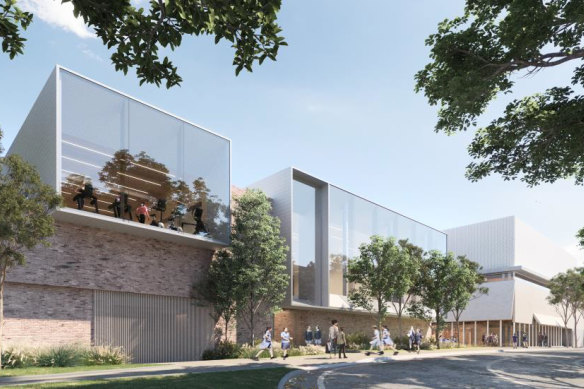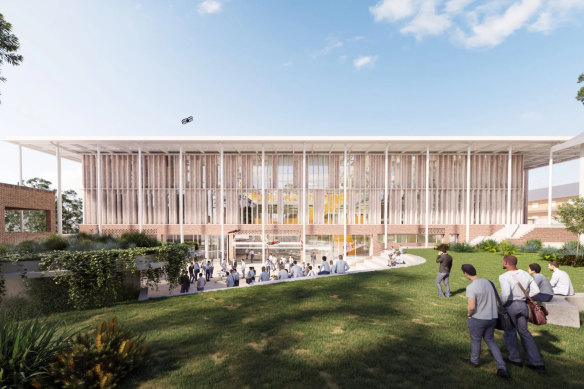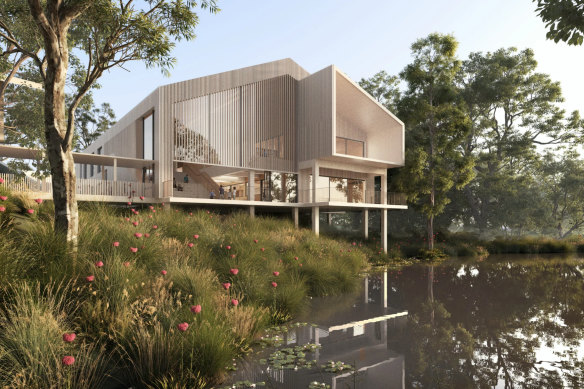- Exclusive
- National
- NSW
- Private schools
This was published 8 months ago
Three Sydney private schools draft more than $400 million in new building plans
By Lucy Carroll
Three of Sydney’s private schools are planning to spend a combined $419 million on major building upgrades, with proposals in the pipeline for science centres, performing arts spaces and new sports complexes.
The King’s School has submitted plans for a campus development worth $170 million over the next decade, which includes a new science and technology building, nine staff townhouses and a primary school performing arts centre.

An artist impression of MLC School’s proposed aquatic centre expansion.
MLC School in Burwood is planning a $108 million performing arts and sports centre, including a 400-seat theatre and health centre, while Waverley College has lodged a proposal for a $141 million overhaul of buildings and classrooms over 15 years.
The plans are contained in applications to the NSW Department of Planning and Environment. Multiple schools across sectors have received approval for capital works in the past two years.
Shore School has lodged plans to expand its student numbers by 450, while Cranbrook is in the early stages of considering a new science and technology building ahead of its transition to co-ed and plans to add another 260 students.
Over the past five years, many large private schools have used the “state significant development” approval pathway to bundle building projects together in master plans rather than apply for several upgrades via local councils.

An impression of a new STEAM building for senior students at The King’s School.
Alaine Roff, director at planning consultancy Urbis, said the advantage of using “master-planned approaches” was that key issues for local communities – including traffic, views, scale and noise – are addressed by schools “upfront, rather than in a piecemeal and ad hoc way”.
Proposals with a capital investment of more than $50 million are considered a state-significant development by NSW.
Parents and donors fund building projects at most private schools. Apart from for-profit Reddam House, which is building a North Sydney campus, all private schools that have lodged plans receive government funding, generally $4 million to $15 million a year, depending on their size.
Recurrent government funding cannot be used for capital works, although public funding can be used to fund interest payments.
Some private schools are losing money as funding levels are adjusted for fairness under the Gonski model.
University of Sydney education professor Helen Proctor said the proposals planning more than a decade ahead showed schools were confident in future enrolment numbers.
“The schools have the security of foundations and personnel that can be dedicated to fundraising,” she said.
The proposals come as rising teacher wages pile pressure on school operational budgets, with some institutions indicating fees will rise between 6 and 9 per cent in 2025.
While public school teachers received a pay increase, government school budgets were slashed by up to $148 million this year, and tens of millions in unspent discretionary funds were frozen from public school bank accounts.
The King’s masterplan development, which extends to 2035, also includes “concept plans” for a sports pavilion, new boarding and day boy houses, and an entrance through land owned by Tara Anglican School for Girls.
The first phases include a new performing arts centre and general learning unit for the preparatory school, lifting its junior school student cap by 56 pupils.
In a letter to the school community, King’s headmaster, Tony George, said the plans included a “cutting-edge” science building.
“The cost to deliver the above facilities over the coming decades is not additional to that investment – it simply wraps all upcoming capital improvements into a single strategic plan,” he said.
Waverley College’s proposal also includes an increase to its student cap, as well as a new six-storey science building, car parking and tennis court facilities.
All-girls school MLC has lodged plans for a performing arts and sports complex and a longer-term plan to extend its aquatic centre.

An image showing part of The King’s School’s plans for a new general learning unit at the primary school.
A school spokesperson said the second pool in the aquatic centre would be dedicated to community use and learn-to-swim programs.
MLC’s new performing arts centre will include a theatre, 12 instrument rooms, two dance studios and drama studios. Pymble Ladies College will build six new dance studios and after-hours care, while Scots College recently opened a new student learning centre modelled on a Scottish baronial castle.
Proctor said the development of “large or extravagant buildings are unlikely to add much, if anything, to the core business of schools, which is teaching and learning”.
“For academic learning the most important thing is having teachers in classrooms that are well maintained and functional,” she said.
“The more you build, the more expensive it is to maintain the facilities, and it also guarantees high costs into the future. It is committing the schools to everlasting need for raising more money.
“There is a pressure to compete, and it can be a point of distraction. But I’m not sure the pressure is coming from parents. There are a lot of extracurricular facilities which schools see as adding value.”
She said the supply of public funding could allow schools to free up money that would have needed to be spent on school operational costs and put it towards building projects.
Association of Independent Schools of NSW chief executive Margery Evans said many schools are refurbishing ageing facilities such as science labs and building libraries.
“In 2023, the NSW independent sector spent over $700m on capital expenditure, land and buildings, a relatively consistent annual amount since 2016. The independent sector needs to expand rapidly to meet parent demand,” she said.
Get the day’s breaking news, entertainment ideas and a long read to enjoy. Sign up to receive our Evening Edition newsletter here.